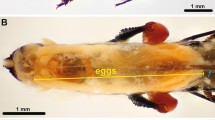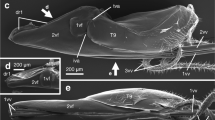Abstract
There are relatively few published illustrations of ovipositors for harvestmen belonging to the suborder Laniatores. As a result, the ovipositor of these harvestmen has largely been ignored as a source of informative characters. We used scanning electron microscopy to examine the ovipositor of eight species representing several major lineages (Gonyleptoidea, Phalangodoidea, Samooidea, and Zalmoxoidea). We observed interspecific variation with respect to the number of external lobes on the distal tip, the surface texture of the distal tip, and the morphology of the peripheral setae. The ovipositors of Bishopella (Phalangodoidea) and Stygnomma (Samooidea) were similar in appearance and differed with respect to the number and position of peripheral setae. We observed significant interspecific variation among the gonyleptoidean species, especially with respect to the peripheral setae. The ovipositors of Zalmoxoidea harvestmen had smooth, spatulate peripheral setae but differed with respect to the surface texture of the distal tip. The unusual morphology of these setae has not been observed previously and may represent a new synapomorphy for the family. Characters based upon ovipositor morphology have the potential to illuminate phylogenetic relationships within and between families and genera in these harvestmen.






Similar content being viewed by others
References
Bennett MK, Townsend VR Jr (2013) Reproductive morphology of three species of Neotropical harvestmen (Opiliones, Laniatores, Gonyleptoidea). J Morphol 274:1415–1424
Bragagnolo C, Hara MR, Pinto-da-Rocha R (2015) A new family of Gonyleptoidea from South America (Opiliones, Laniatores). Zool J Linn Soc 173:296–319
Briggs TS (1971a) The harvestman family Triaenonychidae in North America (Opiliones). Occ Pap Calif Acad Sci 90:1–43
Briggs TS (1971b) Relict harvestmen from the Pacific Northwest (Opiliones). Pan-Pac Entomol 47:165–178
DaSilva MB, Gnaspini P (2009) A systematic revision of the Goniosomatinae (Arachnida: Opiliones: Gonyleptidae), with cladistics analysis and biogeographic notes. Invert Syst 23:530–624
Giribet G, Kury AB (2007) Phylogeny and Biogeography. In: Pinto-da-Rocha R, Machado G, Giribet G (eds) Harvestmen: the biology of Opiliones. Harvard University Press, Cambridge, pp 62–87
Goodnight ML, Goodnight CJ (1976) Observations on the systematics, development, and habits of Erginulus clavotibialis (Opiliones: Cosmetidae). Trans Am Micro Soc 95:654–664
Goodnight CJ, Goodnight ML (1983) Opiliones of the family Phalangodidae found in Costa Rica. J Arachnol 11:201–242
Guffey CA, Townsend VR Jr, Felgenhauer BE (2000) External morphology and ultrastructure of the prehensile region of the legs of Leiobunum nigripes (Arachnida, Opiliones). J Arachnol 28:231–236
Hara MR, Pinto-da-Rocha R (2010) Systematic review and cladistics analysis of the genus Eusarcus Perty 1833 (Arachnida, Opiliones, Gonyleptidae). Zootaxa 2698:1–136
Hunt GS, Hickman JL (1993) A revision of the genus Lomanella Pocock and its implications for family level classification in the Travunioidea (Arachnida: Opiliones: Triaenonychidae). Rec Aust Mus 45:81–119
Kury AB (2003) Annotated catalogue of the Laniatores of the New World (Arachnida, Opiliones). Rev Ibérica Aracnol 1:1–337
Kury AB (2014) Why does the Tricommatinae position bounce so much within Laniatores? A cladistics analysis, with description of a new family of Gonyleptoidea (Opiliones, Laniatores). Zool J Linn Soc 172:1–48
Kury AB, Villareal Manzanilla O, Sampaio C (2007) Redescription of the type species of Cynorta (Arachnida, Opiliones, Cosmetidae). J Arachnol 35:325–333
Machado G, Macías-Ordóñez R (2007) Reproduction. In: Pinto-da-Rocha R, Machado G, Giribet G (eds) Harvestmen: the biology of Opiliones. Harvard University Press, Cambridge, pp 414–454
Macías-Ordóñez R, Machado G, Pérez-González A, Shultz JW (2010) Genitalic evolution in Opiliones. In: Leonard J, Cordoba-Aguilar A (eds) The evolution of primary sexual characters in animals. Oxford University Press, New York, pp 285–306
Martens J (1986) Die Großgliederung der Opiliones und die evolution der Ordnung (Arachnida). In: Barrientos JA (ed) Proceedings of the 10th international congress of arachnology. Instituto Pirenaico de Ecología & Grupo de Aracnología, Barcelona, Spain, pp 289–310
Martens J, Hoheisel U, Götze M (1981) Comparative anatomy of the ovipositors of the Opiliones as a contribution to the phylogeny of the order (Arachnida). Zool Jb Anat 105:13–76
Maury EA (1988) Triaenonychidae sudamericanos. V. Un nuevo género de opiliones cavernícolas de la Patagonia (Opiliones, Laniatores). Mém Biospéol 15:117–131
Nation JL (1983) A new method for using hexamethyldisilazane for preparation of soft insect tissue for scanning electron microscopy. Stain Technol 58:347–351
Pinto-da-Rocha R, Benedetti AR, de Vasconcelos EG, Hara MR (2012) New systematic assignments in Gonyleptoidea (Arachnida, Opiliones, Laniatores). ZooKeys 198:25–68
Pinto-da-Rocha R, Bragagnolo C, Marques FPL, Junior MA (2014) Phylogeny of harvestmen family Gonyleptidae inferred from a multilocus approach (Arachnida: Opiliones). Cladistics 30:519–530
Proud DN, Víquez C, Townsend VR Jr (2011) Paternal care in a Neotropical harvestman (Arachnida: Cosmetidae) from Costa Rica. J Arachnol 39:497–499
Rodriguez AL, Townsend VR Jr, Johnson MB, White TB (2014) Interspecific variation in the microanatomy of cosmetid harvestmen (Arachnida, Opiliones, Laniatores). J Morphol 275:1386–1405
Schwendiger PJ, Martens J (2002) Penis morphology in Oncopodidae (Opiliones, Laniatores): Evolutionary trends and relationships. J Arachnol 30:425–434
Sharma PP, Giribet G (2011) The evolutionary and biogeographic history of the armoured harvestmen—Laniatores phylogeny based on ten molecular markers, with the description of two new families of Opiliones (Arachnida). Invert Syst 25:106–142
Šilhavỳ V (1977) Further cavernicolous opilionids from Mexico. Quad Acc Naz Lincei 171:219–233
Šilhavỳ V (1979) Opilionids of the suborder Gonyleptomorphi from the American caves, collected by Dr. Pierre Strinati. Rev Suisse Zool 86:321–334
Spicer GS (1987) Scanning electron microscopy of the palp sense organs of the harvestman Leiobunum townsendi (Arachnida: Opiliones). Trans Am Micro Soc 106:232–239
Walker EA, Townsend VR Jr (2014) Ovipositor morphology of cosmetid harvestmen (Arachnida, Opiliones, Laniatores): a new source of informative characters. J Morphol 275:1376–1385
Willemart RH, Gnaspini P (2003) Comparative density of hair sensilla on the legs of cavernicolous and epigean harvestmen (Arachnida: Opiliones). Zool Anz 242:353–365
Willemart RH, Chelini MC, De Andrade R, Gnaspini P (2007) An ethological approach to a SEM survey on sensory structures and tegumental gland openings of two Neotropical harvestmen (Arachnida, Opiliones, Gonyleptidae). Ital J Zool 74:39–54
Willemart RH, Farine J-P, Gnaspini P (2009) Sensory biology of Phalangida harvestmen (Arachnida, Opiliones): a review, with new morphological data on 18 species. Acta Zool 90:209–227
Acknowledgments
This research was supported by the VWC Science Undergraduate Research Fund (MSB), the VWC Electron Microscopy Lab, and summer faculty development grants (VRT). Specimens were collected in the field with help from D. Proud (University of Louisiana at Lafayette), C. Víquez (INBio), M. Moore (Mercer University), J. Campbell (High Point University), A. Abbate, B. Campbell (University of Florida), and Stephen Broadbridge (Caribbean Discovery Tours). Special thanks to Andrea Rodriguez for assistance with specimen preparation and the operation of the SEM, and Daniel Proud and two anonymous reviewers for insightful comments on earlier versions of this manuscript. Specimens were legally exported from Trinidad (001339) and Costa Rica (01607). Voucher specimens were deposited into the natural history collection at the American Museum of Natural History, New York.
Author information
Authors and Affiliations
Corresponding author
Additional information
Communicated by A. Schmidt-Rhaesa.
Rights and permissions
About this article
Cite this article
Townsend, V.R., Bertram, M.S. & Milne, M.A. Variation in ovipositor morphology among laniatorean harvestmen (Arachnida: Opiliones). Zoomorphology 134, 487–497 (2015). https://doi.org/10.1007/s00435-015-0269-4
Received:
Revised:
Accepted:
Published:
Issue Date:
DOI: https://doi.org/10.1007/s00435-015-0269-4




